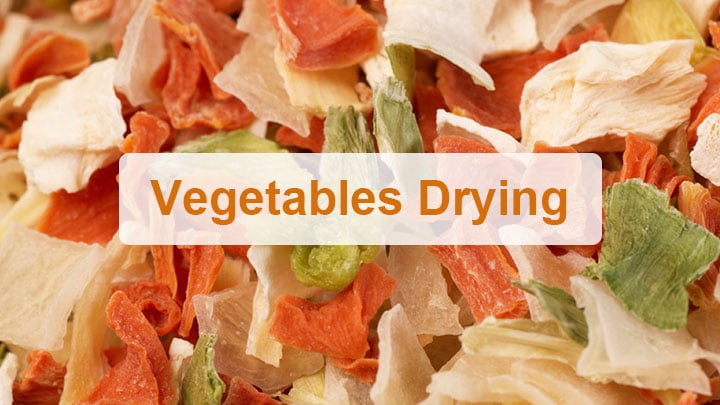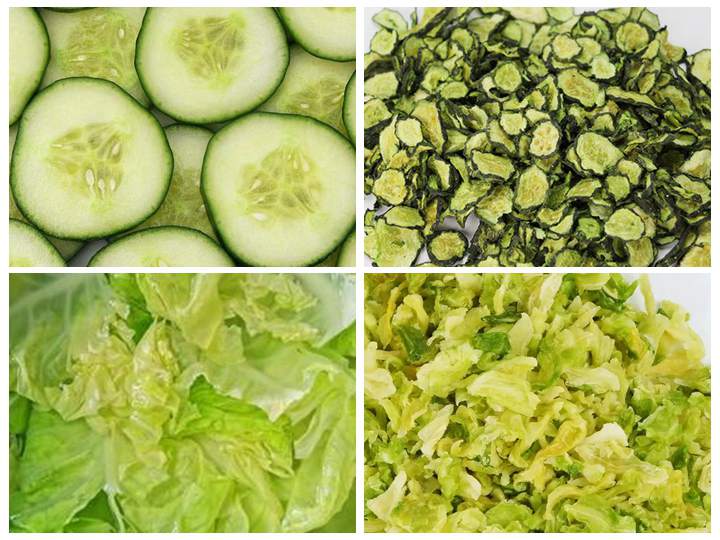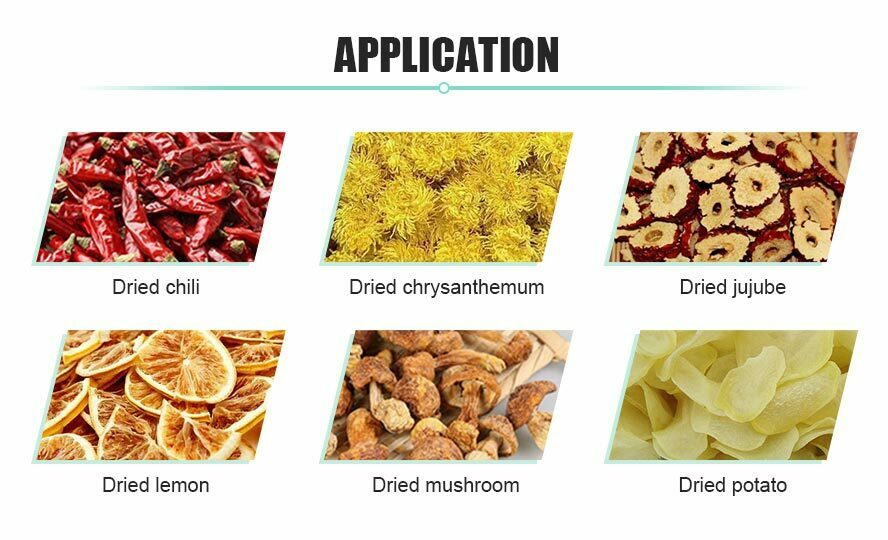
Dehydrated vegetables are made by drying fresh vegetables to remove most of the moisture content. The dehydrated vegetables can basically maintain the original color and nutrients. Compared with fresh vegetables, dehydrated vegetables have the advantages of small size, lightweight, and convenient transportation. Moreover, the dehydrated vegetables can be restored by immersing them in clean water when eating, and the original color, nutrition, and flavor of the vegetables can be retained. In the vegetable peak season, surplus vegetables can be processed into dehydrated vegetables, which are easy to store and transport.
உலர்ந்த பசல்பழங்களின் ஊட்டச்சத்துக்கள் என்னவாக இருக்கின்றன?

பசல்பழங்கள் மனித உடலுக்கு தேவைப்படுவது போல் தினசரி உணவுகளில் முக்கிய அத்தியாவசிய உணவுகள் ஆகும். இவற்றில் பல வகையான வைட்டமின் மற்றும் மனுஷ உடலுக்குத் தேவையான மெட்டல்கள் போன்ற ஊட்டச்சத்துகள் வழங்கப்பட முடியும். அதாவது உலர்ந்த பசல்பழங்களுக்கும் ஊட்டச்சத்துக்கள் இன்னும் இருக்கும் அளவு உள்ளது. விண்வெளியில் ஊட்டச்சத்துகளை கூட்டுவதற்காக அஸ்ட்ரோனாட்ட்கள் சாப்பிடும் பசல்பழங்கள் உண்மையில் உலர்ந்த பசல்பழங்களாக இருக்கும். பசல்பழங்களை உலர்த்தும் போது அதிகமான நீர்சார் ஊட்டச்சத்துகள் குறையவில்லை. இது நீரின் பெரும்பங்கம் ஈறி விடும் போது ஊட்டச்சத்துகள் அதிகமாக குவையும். நாம் உலர்ந்த பசல்பழங்களைச் சாப்பிடும் போது பசல்பழங்களின் ஊட்டச்சத்துக்களை நாம் பெறுவது புதியதைப்போல உயர்ந்திருக்கலாம். மேலும் சில பசல்கள், மீன்கட்டி போல, உலர்ந்தவருக்கும் பிறகு இன்னும் சத்தமானதாக இருக்கும். தொழில்நுட்பம் தொடர்ந்தும் முன்வருவது மட்டுமின்றி, உலர்ந்த பசல்பழங்கள் பசல்பழங்களின் பல உணவு அம்சங்களில் பெரும்பாலானவற்றை காட்சி நின்று பராமரிக்க முடியும்.
எங்கள்தைவிட ஏன் தேர்வு செய்வோம் vegetable drying equipment?
பசல்கள் மற்றும் பழங்கள் தண்ணீருடன் நிறைய உள்ளவையென carbon dioxide என்று கூறுவது போன்ற காரணத்தால், உலர்க்கும் போது குறைந்த வெப்பநிலை பாதுகாக்கப்பட வேண்டும். இது பசல்பழங்களின் ஊட்டச்சத்துக்களை சேமிக்க உதவும். மார்க்கெட்டில் கிடைக்கும் உலர்ந்த பசல்பழங்கள் பெரும்பாலும் AD பசல்கள் மற்றும் FD பசல்கள் என்று வகைப்படுத்தப்படுகின்றன. AD பசல்கள் என்பது அப்பகுதியில் வெப்பமேழு., மைக்ரோவேவே, பூப்பதம் போன்ற முறைகளால் உலர்த்தப்படுகின்றன. நீரை mainly evaporate என வெளியேற்கிறார். FD பசல்கள் Vacuum Freeze-drying மூலம் உலர்த்தப்படுகிறது; நீர் நேரடியாக sublimation மூலம் வெளியேற்றப்படுகிறது. FD பசல்களுக்கே சிறந்த சுவைப் பரிமாணம் மற்றும் ஊட்டச்சத்துகள் அதிகம், ஆனால் yield குறைந்துள்ளது; உபகரணங்கள் மிகவும் செலவாகும். தற்போதுதான் சந்தையில் அதிகமாக உலர்ந்த பசல்கள் வெப்பமான காற்றால் உலர்த்தப்படுகின்றன.

பரம்பரைக்கே புரிந்த மரபு முறைகள் பெரும்பாலும் காற்றில் உலர்த்து, சூரிய ஒளியில் உலர்த்து செய்து வருகின்றன. இந்த முறைகளில் பல குறைகளும் உள்ளன: அதிக வெப்பத்திற்கான செயல்திறன் குறைப்பு, தான்கள் மேற்பரப்பு, சூழ்நிலை தாக்கங்களுக்கு அதிகமான தாக்கம். எங்கள் காற்று ஆற்றல் வெப்பபம்பு பசல்யுரைசிறார் மிகக் குறைந்த மின்னல் பயன்படுத்தி சுற்றியுள்ள சூழலிலிருந்து நிறைய வெப்பம் பெற்று சுடுகாட்டிற்கு மடக்குவதைக் கொண்டுள்ளது. இது குறைந்த எரிசாஸ் மற்றும் அதிக உள்நோக்கிலான மாற்றமான விகிதம்.
The process of vegetable drying
- கச்சா பொருட்களின் தேர்வு: சிறந்த இறைச்சி தரத்துடன் கூடிய காய்கறி வகைகளை தேர்ந்தெடுக்கவும். நீரிழிவு செய்யும் முன், நீங்கள் சிறந்தவற்றை கடுமையாக தேர்ந்தெடுத்து, கீழ்த்தரமானவற்றை அகற்ற வேண்டும், மற்றும் பூச்சிகள், சிதைந்த மற்றும் சுருக்கமான பகுதிகளை அகற்ற வேண்டும். காய்கறிகள் 80% பழுதடைந்த நிலையில் இருக்க வேண்டும், மேலும் அதிகமாக பழுத்த அல்லது குறைவாக பழுத்தவை கூட தேர்ந்தெடுக்கப்பட வேண்டும். காய்கறிகளை சுத்தமான நீரில் கழுவிய பிறகு, குளிர்ந்த இடத்தில் உலர வைக்க வேண்டும், ஆனால் சூரியனுக்கு வெளியில் வைக்கக்கூடாது.
- வெட்டுதல் மற்றும் பிளாஞ்சிங்: சுத்தம் செய்யப்பட்ட கச்சா பொருட்களை தயாரிப்பு தேவைகளுக்கு ஏற்ப துண்டுகள், நெளிகள், பட்டைகள் மற்றும் பிற வடிவங்களில் வெட்டவும். பிளாஞ்சிங் செய்யும் போது, வெப்பநிலை வெவ்வேறு கச்சா பொருட்களுக்கு மாறுபடும். நீரின் வெப்பநிலை பொதுவாக 150℃ க்கும் மேலாக இருக்கும் மற்றும் பொதுவான பிளாஞ்சிங் நேரம் 2 முதல் 4 நிமிடங்கள் வரை இருக்கும். இலைகளான காய்கறிகளை பிளாஞ்ச் செய்ய வேண்டாம்.
- குளிர்வித்து வடிகட்டி: பிளாஞ்ச் செய்யப்பட்ட காய்கறிகளை உடனே குளிரவைக்க வேண்டும் (பொதுவாக குளிர்ந்த நீரில் கழுவப்படுகிறது) அறையின் வெப்பநிலைக்கு விரைவாக குறைக்க. குளிர்ந்த பிறகு, நீரை அதிரும் நீர் பிரிக்கிற்று மூலம் வடிகட்டி உலர்த்தும் நேரத்தை குறைக்கலாம். பிறகு காய்கறிகளை பரப்பி, ஒரு சில நேரம் குளிர விடுங்கள், உலர்த்துவதற்கான தயாரிப்புக்கு.

- உலர்வு: உலர்த்தும் போது வெவ்வேறு காய்கறி வகைகளுக்கு ஏற்ப வெப்பநிலை, நேரம், நிறம் மற்றும் ஈரப்பதம் உள்ளடக்கத்தை தீர்மானிக்க வேண்டும். உலர்த்துவதற்காக காற்றின் ஆற்றல் வெப்ப பம்ப் உலர்த்தியைப் பயன்படுத்துவது சிறந்தது. காற்றின் ஆற்றலின் வெப்பம் மெதுவாக அதிகரிக்கப்படுகிறது, இது காய்கறிகளின் அசல் திசு நார்களை மற்றும் ஊட்டச்சத்துக்களை அதிகமாக பராமரிக்க உதவுகிறது. காய்கறிகளை பொருள் Tray இல் வைக்கவும், பொருள் Tray ஐ பொருள் லாரியில் உள்ளிடவும், அதை உலர்த்தும் அறைக்கு தள்ளவும், மூடிய கதவை மூடவும், மற்றும் உலர்த்தும் உற்பத்தியைத் தொடங்கவும். காற்றின் ஆற்றல் வெப்ப பம்ப் உலர்த்தும் செயல்முறையில், காய்கறிகள் காற்றுடன் தொடர்பில் இருக்கும் போது, காற்றின் ஆற்றலிலிருந்து பெரிய அளவிலான வெப்பம் உறிஞ்சப்படும். ஒரு பகுதி காய்கறிகளின் உள்ளக வெப்பநிலையை அதிகரிக்க பயன்படுத்தப்படுகிறது, மற்றொரு பகுதி காய்கறிகளில் உள்ள ஈரப்பதத்தை மாறுபடுத்த மற்றும் வाष்பமாக்க பயன்படுத்தப்படுகிறது. காற்று தொடர்ந்து காய்கறிகளுக்கு வெப்பத்தை மாற்றி, காய்கறிகளின் ஈரப்பதத்தை விலக்கி வைக்கும் செயல்முறை. இந்த செயல்முறை மூன்று கட்டங்களில் பிரிக்கப்படுகிறது: வெப்பமூட்டும் கட்டம், நிலையான வீதத்தில் உலர்த்தும் கட்டம், மற்றும் மந்தமாக்கும் உலர்த்தும் கட்டம்.
- சேமிப்பு கட்டம்: உலர்த்துதல் முடிந்த பிறகு, அதை உடனே தொகுக்க வேண்டாம். காய்கறிகள் முழுமையாக குளிர்ந்ததும் மற்றும் அறையின் வெப்பநிலைக்கு ஏற்ப மாறுபட்டதும் வரை காத்திருப்பது சிறந்தது. தொகுக்கப்பட்ட உலர்ந்த காய்கறிகளை உலர்ந்த மற்றும் குளிர்ந்த இடத்தில் வைக்க வேண்டும்.
பசல்பழங்களை உலர்த்தும் இயந்திரத்தின் பயன்பாடுகள்
Our vegetable drying machine is also suitable for fruits, fungi, Chinese medicinal materials, seafood, crops, and some chemical products. It also can be customized according to the user’s demands for different products.

